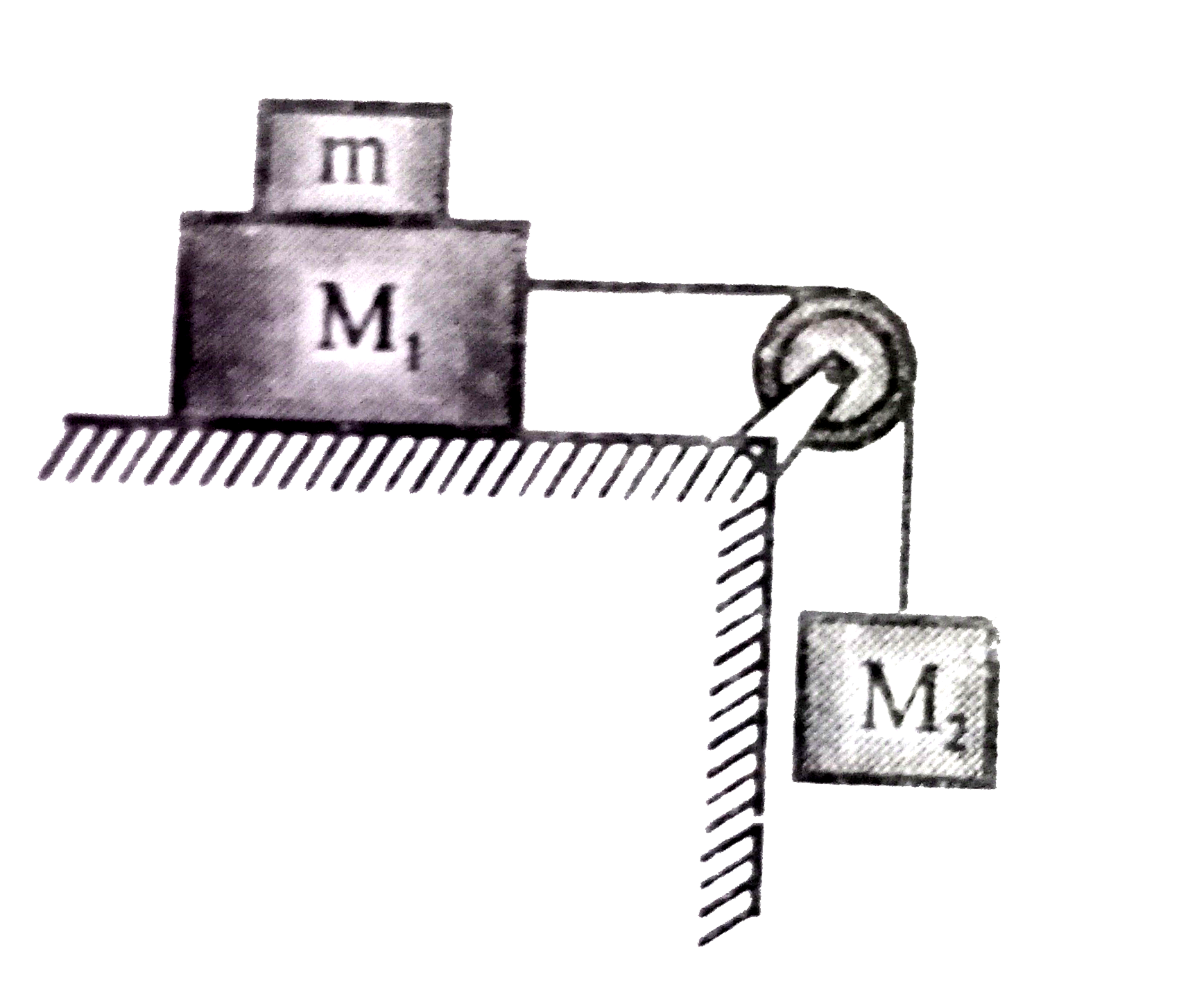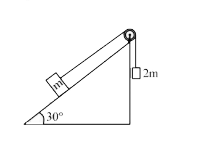Two blocks of masses m1andm2(m1>m2) connected by a massless string passing over a frictionless pulley Magnitude of acceleration of blocks would be
(m1−m2m1+m2)g
(m1+m2m1−m2)g
(m2−m1m1+m2)g
(m2+m1m2−m1)g
To find the magnitude of acceleration of the two blocks connected by a massless string over a frictionless pulley, we can follow these steps:
Step 1: Identify the forces acting on each block
- For block m1 (the heavier block), the force due to gravity acting downwards is m1g.
- For block m2 (the lighter block), the force due to gravity acting downwards is m2g.
Step 2: Write the equations of motion for both blocks
- For block m1:
Fnet1=m1g−T
where T is the tension in the string.
- For block m2:
Fnet2=T−m2g
Step 3: Apply Newton's second law
According to Newton's second law, F=ma, we can express the net forces in terms of acceleration a:
- For block m1:
m1a=m1g−T(1)
- For block m2:
m2a=T−m2g(2)
Step 4: Solve the equations simultaneously
From equation (1):
T=m1g−m1a(3)
Substituting equation (3) into equation (2):
m2a=(m1g−m1a)−m2g
Rearranging gives:
m2a+m1a=m1g−m2g
Factoring out a:
a(m1+m2)=(m1−m2)g
Now, solving for a:
a=(m1−m2)gm1+m2
Step 5: Conclusion
The magnitude of the acceleration of the blocks is given by:
a=(m1−m2)gm1+m2
- For block m1 (the heavier block), the force due to gravity acting downwards is m1g.
- For block m2 (the lighter block), the force due to gravity acting downwards is m2g.
- For block m1:
Fnet1=m1g−T
where T is the tension in the string.
Fnet2=T−m2g
According to Newton's second law, F=ma, we can express the net forces in terms of acceleration a:
- For block m1:
m1a=m1g−T(1)
m2a=T−m2g(2)
From equation (1):
T=m1g−m1a(3)
Substituting equation (3) into equation (2):
m2a=(m1g−m1a)−m2g
Rearranging gives:
m2a+m1a=m1g−m2g
Factoring out a:
a(m1+m2)=(m1−m2)g
Now, solving for a:
a=(m1−m2)gm1+m2
The magnitude of the acceleration of the blocks is given by:
a=(m1−m2)gm1+m2
Similar Questions
Three blocks of masses m1=4kg,m2=2kg,m3=4kg are connected with ideal strings passing over a smooth, massless pulley as shown in figure. The acceleration of blocks will be (g=10m/s2)

View SolutionTwo masses m1 and m2(m2>m1) are hanging vertically over frictionless pulley. The acceleration of the two masses is :

View Solution
Knowledge Check
Two blocks of masses m1 and m2(m1>m2) are connected by a massless threads, that passes over a massless smooth pulley. The pulley is suspended from the ceiling of an elevator. Now the elevator moves up with uniform velocity v0 Now, select the correct options:
 AMagnitude of acceleration of m1 with respect to ground is greater than (m1−m2)gm1+m2BMagnitude of acceleration of m1 with respect to ground is equal to (m1−m2)gm1+m2CTension in the thread that connects m1 and m2 is equal to 2m1m2gm1+m2DTension in the thread that connects m1 and m2 is greater than 2m1m2gm1+m2
AMagnitude of acceleration of m1 with respect to ground is greater than (m1−m2)gm1+m2BMagnitude of acceleration of m1 with respect to ground is equal to (m1−m2)gm1+m2CTension in the thread that connects m1 and m2 is equal to 2m1m2gm1+m2DTension in the thread that connects m1 and m2 is greater than 2m1m2gm1+m2Two bodies of massless string passing over a frictionless pulley. The acceleration of the system is (g=9.8m/s2)
A4.9m/s2B2.45m/s2C1.4m/s2D9.5m/s2Two blocks of masses m1 and m2 are connected by a string of negligible mass which pass over a frictionless pulley fixed on the top of an inclined plane as shown in figure. The coefficient of friction between m1 and plane is μ.
 AIf m1=m2, the mass m1 first begin to move up inclined plane when the angle of inclination θ, then μ=secθ−tanθBIf m1=m2, then mass m1 first begin to side down the plane if μ=secθ−tanθ.CIf m1=2m2, then mass m1 first begins to slide down the plane if μ=2tanθ.DIf m1=2m2, then mass m1 first begins to slide down the plane if μ=tanθ−12secθ.
AIf m1=m2, the mass m1 first begin to move up inclined plane when the angle of inclination θ, then μ=secθ−tanθBIf m1=m2, then mass m1 first begin to side down the plane if μ=secθ−tanθ.CIf m1=2m2, then mass m1 first begins to slide down the plane if μ=2tanθ.DIf m1=2m2, then mass m1 first begins to slide down the plane if μ=tanθ−12secθ.
Two masses m and m (m>m) are connected by massless flexible and inextensible string passed over massless and frictionless pulley. The acceleration of centre of mass is
View SolutionTwo blocks of mass m1andm2 are connected by light inextensible string passing over a smooth fixed pulleuy of negligible mass. The acceleration of the centre of mass of the system when blocks move under gravity is :
View SolutionTwo blocks of masses M1=4 kg and M2=6kg are connected by a string of negligible mass passing over a frictionless pulley as shown in the figure below. The coefficient of friction between the block M1 and the horizontal surface is 0.4. when the system is released, the masses M1 and M2 start accelrating. What additional mass m should be placed over M1 so that the masses (M1+m) slide with a uniform speed?

View SolutionTwo blocks of masses m and 2m are connected by a light string passing over a frictionless pulley. As shown in the figure, the mass m is placed on a smooth inclined plane of inclination 30° and 2m hangs vertically. If the system is released, the blocks move with an acceleration equal to :

View SolutionTwo blocks of masses m1 and m−2m>(m2) are connected by massless threads that passes over a massless smooth pulley The pulley is suspended from the ceiling of an elevator Now the elevator moves up with uniform velocity V0 Now select the correct options
 .
.
View Solution
